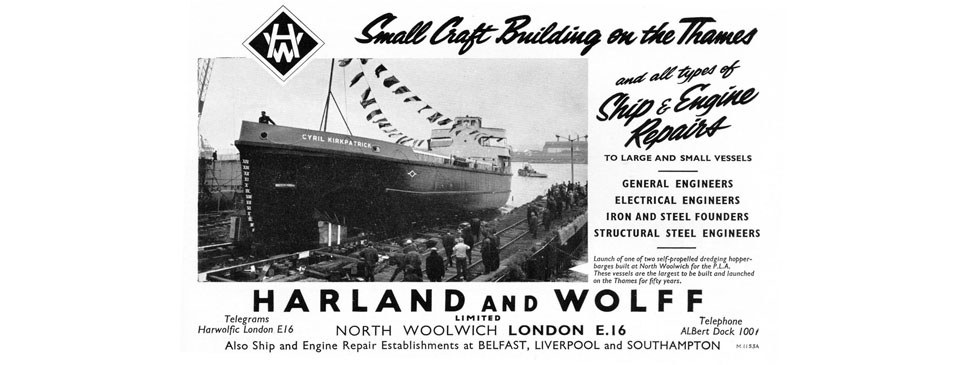Harland & Wolff on the Thames

This article is based on a talk I gave to the Royal Docks History Club as part of the Thames Festival 2022.
Harland & Wolff is best-known as one of Britain’s premier ship-building companies, with a long history stretching back to the middle of the 19th century. From the 1920s until the 1970s the company also built smaller vessels, as well as repairing ships, from several sites in London’s docks.
Harland & Wolff has been one of Britain’s major ship-building operations since the mid-19th century, perhaps most famously building the Titanic at their Belfast yard. For many decades that also had ship and engine repair facilities in the London docks.
As a young man, in 1846 Edward Harland started an apprenticeship at the Robert Stephenson engineering works at Newcastle-upon-Tyne, notable for building early steam locomotives such as the Rocket, but he completed training at a shipbuilding yard in Glasgow. In 1854 he obtained work as a manager at a shipyard in Belfast. Three years later Harland employed the 23-year old German-born Gustav Wolff, the son of a family friend, as his assistant. Wolff had served an apprenticeship in Manchester, where he was working as a draughtsman. Harland purchased the Belfast yard in 1858 where they were working, with financial help from Wolff’s uncle. In around 1860 Wolff became James Harland’s business partner and the yard was renamed Harland & Wolff.
From its early days the Belfast yard was kept busy building cargo ships and passenger liners. During the American Civil War they received orders for steamers for the Southern Confederate States. When Harland died at the end of the 19th century the yard employed 10,000 men and the business was still growing.
An important year for Harland & Wolff was 1911. They began work on the Titanic, the world’s largest passenger liner of the time, which famously sank the following year. The company also acquired its first shipyard on the River Clyde at Glasgow in Scotland in that year, allowing it to increase its output of new ships. At around that time it also started to open new ship repair and engine yards around the United Kingdom and by early 1920s had sites at Liverpool and Southampton.
London was then Britain’s largest commercial port. From the beginning of the 19th century a series of major docks were created either side of the river, each established by individual dock companies. The first of these was the West India Docks across the top of the Isle of Dogs, followed by the London Docks at Wapping, the East India Docks at Blackwall, the Surrey Docks at Rotherhithe, St. Katherine Docks close to the Tower of London, and the Millwall Dock on the Isle of Dogs. As ships grew in size, particularly after the introduction of steam-powered, iron-hulled vessels, they became too large and too deep to fit into those older docks. From the mid-19th century new, larger docks were built further downriver at Plaistow Marshes and Tilbury. The first of these was the Royal Victoria, followed by the Royal Albert, and then Tilbury.
All the London docks were nationalised at the start of the 20th century under the Port of London Authority. They set about creating a big new dock at North Woolwich, connected to the Royal Albert Dock known as the King George V, which was officially opened by the King himself in 1921. Harland & Wolff then took the opportunity to create ship-repair facilities at the new dock.
Ships had been built and repaired on the Thames since the Middle Ages and as ever-bigger shipyards were required they moved further downriver. What really turned the Thames into a major shipbuilding centre was when Henry VIII established naval dockyards at Woolwich and Deptford, either side of his royal palace at Greenwich, in the 16th century. It was further boosted as an industry when the East India Company began building ships at Blackwall in the 18th century. Using the abundance of skilled labour, numerous shipyards sprang up along the Thames, building and repairing all types of commercial and naval vessels, constructing the largest ships, barges and lighters, down to the smallest boats.
During the 19th century there were more than a dozen significant ship-building yards on the Thames, of which the main ones were clustered along the north bank of the river at the Isle of Dogs and Blackwall. Some of the more famous yards were: Russell’s, where the Great Eastern was built on the south of the Isle of Dogs; Wigram’s at Blackwall, Samuda at Cubitt Town, which was close to Yarrow’s; and the Thames Iron Works at Leamouth, whose works football team famously became West Ham United. As the 19th century progressed ships became too large to easily launch them on the Thames and the ship-building industry moved away. It was also more cost-effective to build them in the North-East of England, along the Clyde in Scotland, and at Belfast, which were all closer to where steel was being produced. The Thames yards either moved north, such as Yarrow’s which relocated to Glasgow in 1906, or closed down altogether, or continued as ship repair facilities, such as R.H. Green & Silley Weir at Blackwall, which was formed by the amalgamation of various shipbuilders.


